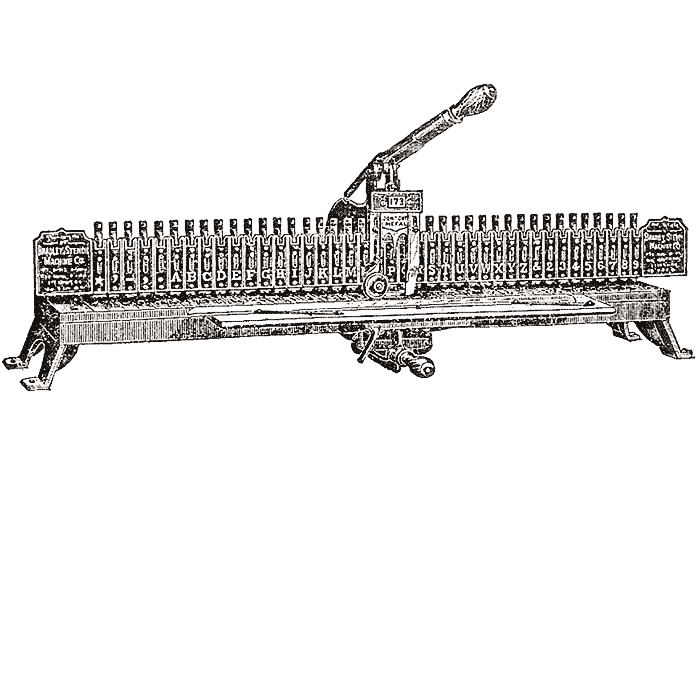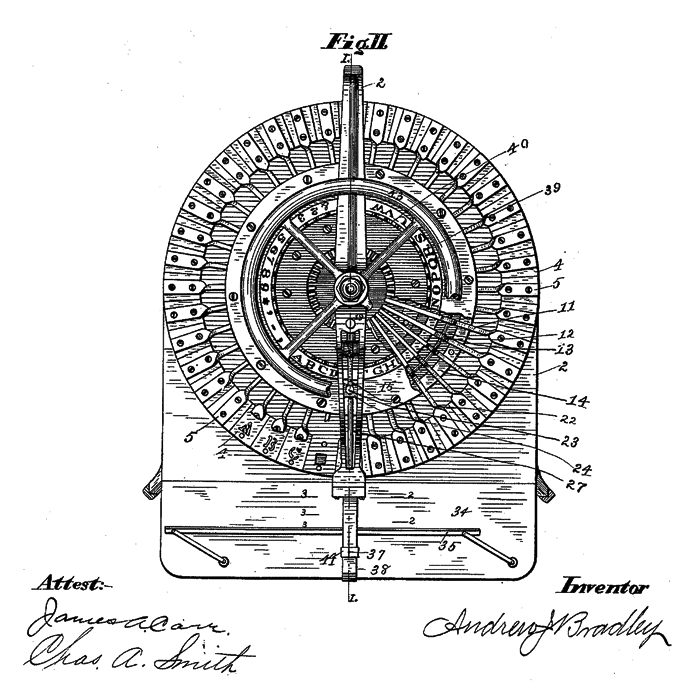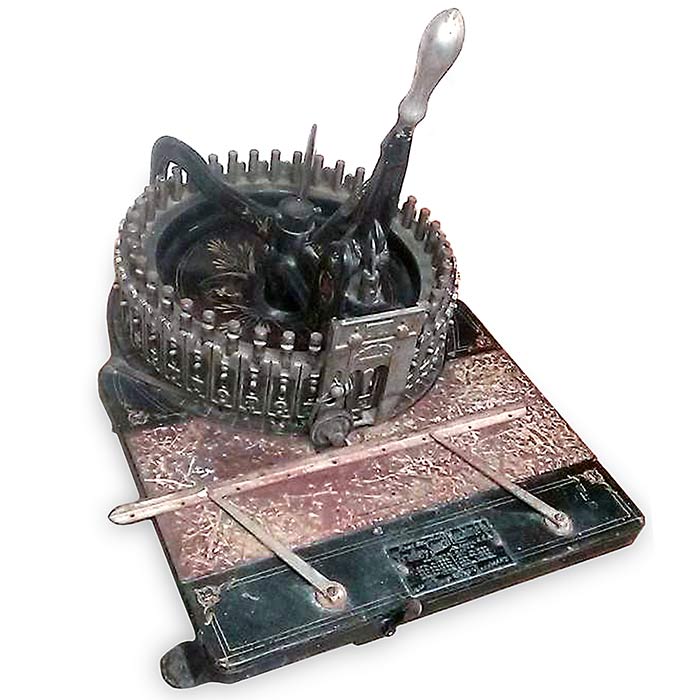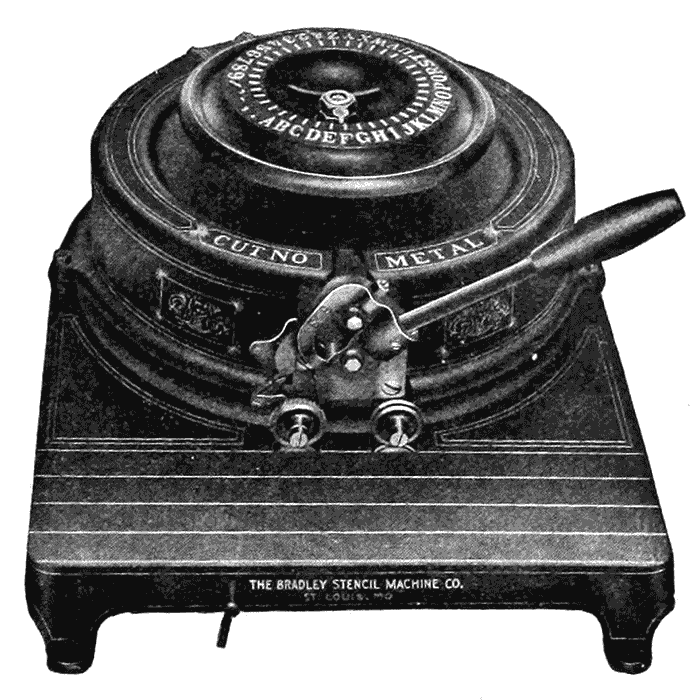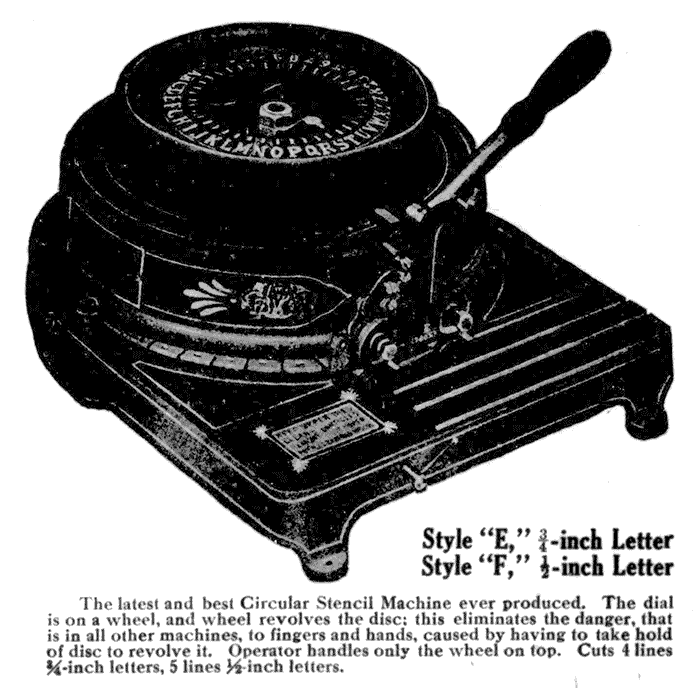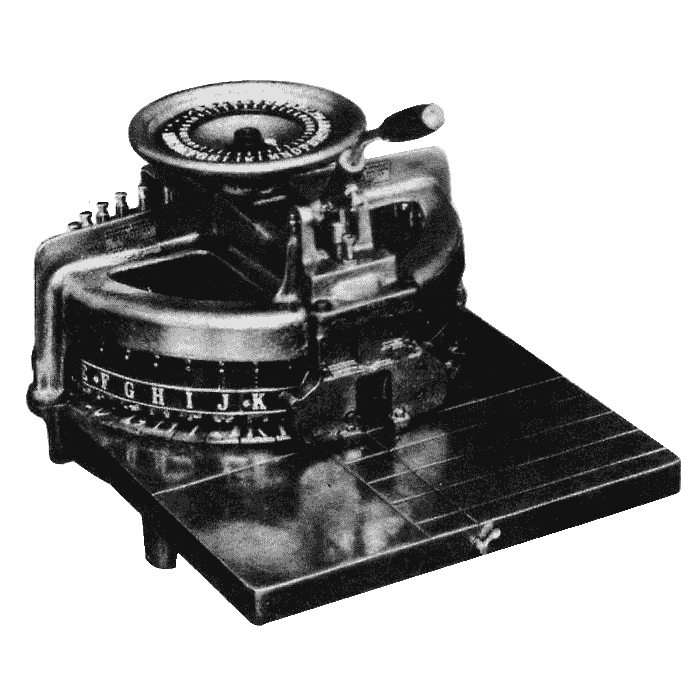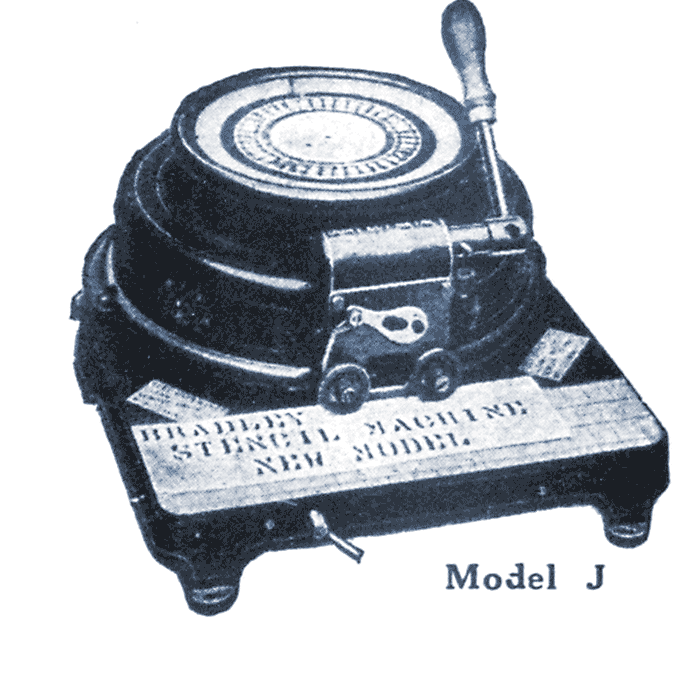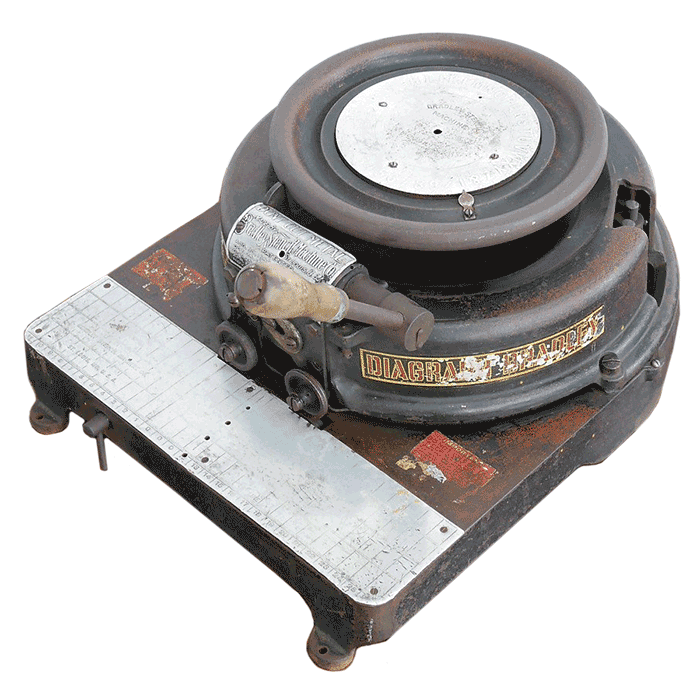Bradley Stencil Machines
Bradley Stencil Cutters
The Long Bradley
The world's first stencil machine was patented in 1893.
The first stencil machines for sale were probably built in 1894.
The machine looked like a long chain of letters on which a lever coupled to a carriage could slide along the chain.
The characters were in a row from A to Z, followed by the numbers and some special characters.
For economic reasons, the letters I and O were also used for the numbers 1 and 0.
(All subsequent manual stencil machines, including competitors, maintained this economy measure.)
The stencil paper was placed on a carriage, and the carriage, was used to slide to the character to be punched.
The machines were built for ½" with a Gothic typeface and for ¾" with a Roman typeface.
The machines were later called the straight line Bradley or «Long Bradley».
The Roman typeface looked a bit like a typewriter typeface.
Very often the typeface looked uneven in gray values.
This was due to the different stem weights of some letters.
The production of punches and dies for characters was new and expensive.
Creating optically evenly weighted characters may have been difficult.
Circular Machines
For even larger letters, the machine would have had to become even longer, which would have been impractical and more expensive.
So the characters were arranged on a circle.
This new model was patented in 1898.
The circular machines were more practical and less expensive.
Nevertheless, the Long Bradley was built in parallel with the circular models until about the late 1930s.
Even after the acquisition and merger with Diagraph, Long Bradley machines and the Giant machines (Bradley Model G and H) continued to be produced for quite some time.
Diagraph discontinued the Bradley J, K, E, and F models, but continued support and parts sales.
The Roman type was also used for some of the circular models.
Model A the ¾ inch and Model B the ½ inch version.
Both of these machines cost $125 each in 1924.
- width: 20"
- length: 65"
- height with stand: 56"
- weight: 120 lbs
- weight: 150 lbs with stand
- image: Long Bradley Stencil Machine
- image: Long Bradley with Stand
- image: Long Bradley with Stand and Operator
Long Bradley Details
Advantages of the straight line Bradley. Easy visibility, letters plainly visible and all in a straight line.
The toughest and most rugged machine made.
Horizontal design, machine can be set against wall.
The only machine on which you can cut seven lines with a ½-inch letter and five lines with a ¾-inch letter.
Few parts, simple construction.
The original witented drop forged punch and ⅛-inch thick heavy hardened die.
The Bradley straight-line stencil machine was the first stencil machine of any kind invented.
Manufactured in 1893, improvements have been made from time to time and it has received many awards and prizes in national and international exhibits including the first place award on several world fairs.
Also received the highest award of the Franklin Institute as the most outstanding invention ol the year.
The straight line Bradley is manufactured in two sizes, the ½-inch with Gothic letter and ¾-inch in with Roman letter.
Equipped with exclusive Bradley drop forged punch.

The ½-inch letter shown above is especially adapted to marking small boxes, narrow slats on crates, parcel post shipments.

The ¾-inch Roman letter is used for muking large boxes, bales, crates, iron, etc. This letter has no sharp comers and is easy to stencil.
Source: Shippers Handy Helper, Diagraph-Bradley Stencil Machine Corp., Edition 1939
TYPE TESTER
Type specimen of the ¾ inch Bradley Roman stencil typeface. >>> To start editing, click the text line!
If you like this font, you can buy a license at astype fonts.
First Circular Stencil Machines
1894 Patent filled
1898 Patent granted
½ and ¾" type size
Probaly Model C for ¾ inch and Model D for ½ inch stencil typeface.
As you can easily see, the model is a derivation of the Long Bradley model.
- image: First Circular Machine, Illustration, 1894
- image: First Circular Machine ca.1900
- image: First Circular Machine with typeface specimen
2. Generation Circular Stencil Machines
ca. 1910 – 1922
½ and ¾" type size
Bradley stencil machine model E for ¾ inch (Roman type) and model F for ½ inch (Gothic type).
The model E cuts 4 lines and the model F cuts 5 lines. The machines are upgraded with housing.
- width: 17"
- length: 22"
- height: 12"
- weight: 125 lbs
- image: Bradley Model E, photo, 1910
- image: Bradley Model E, Illustration, 1912
- image: Bradley Model E, Illustration, 1912
Prior to the production manufacturing of the Model J, this type of machine was built in Model E for ¾ inch letters in 4 lines and Model F for ½ inch letters in 5 lines.
The Giant Models
ca. 1915 – 1938
1¼ and 1½" type size
200 pounds
With the United States entry into World War I looming, larger letters were needed - especially for the marking of overseas cargo.
Bradley responded with the G and H models for 1½ and 1¼ inch letter sizes.
The models were also known as the Bradley Giant models.
The model G features a Roman and the model H a Gothic typface.
In 1924 the model G cost $170 and model H $185.
- width: 21"
- length: 31"
- height: 20"
- weight: 205 lbs
- image 1: Bradley Giant Model G or H
- image 2: Bradley Giant Model G or H
Bradley Giant Details
- Double dial, makes cutting easy and quick.
- Hand wheel operates machine with minimum of effort.
- Ball bearings installed in both model G and H machines.
- Handle leverage design drive punches through with little effort.
- Semi-housed for easy assembly of parts.
- Models G and H are the only large letter machines on which you can cut circular stencils using the automatic feed.
- Circular stencils can be cut on the Jumbo Diagraph but the stencil must be spaced by hand.
These large letter machines are very popular with concerns making export shipments and for stenciling large boxes, heavy crated machinery, bales, and, in fact, anything requiring large letter stencils. These type machine has been purchased by the textile industry than in any other field.

This style letter cut by the model G machine 1 ¼-inch size. Will cut as many as four lines of any length on a sheet of board 8 ½ inches wide.

A sample of the 1 ½-inch letter cut by the Model H is shown above. Will cut as many as four lines on a sheet of board 8 ½ inches wide.
Source: Shippers Handy Helper, Diagraph-Bradley Stencil Machine Corp., Edition 1939
3. Generation Circular Stencil Machines
1922 – 1938
½ and ¾" type size
The third generation of Bradley circular stencil machines were introduced in 1922.
The model J for ¾ inch (Roman type) in 4 lines and model K for ½ inch (Gothic type) in 5 lines.
The new models featuring a flat position (alphabet) disc and a changed position of the lever.
Previews models used a casted metal ring to show the position.
These models cost $110 each in 1924.
- width: 17"
- length:
- height: 14"
- weight: 105 lbs
- image: Bradley Model J, 1922
- image: Bradley Model J,
- image: Bradley Model K, late model with Diagraph label
Bradley Model J and K Details
- Drop forged steel punch.
- ⅛ inch thick dies.
- Dies hand filed, case hardened and hand fitted.
- Only machine with graduated aluminum spacing table for a quick lining up of stencil, recutting of missed letters and accurate spacing.
- Etched aluminum dial plate.
- Balanced hand wheel for easy operation.
- Handle adjustable to two positions.
Drop Forged Punches
Drop forged punches used in all Bradley machines
This Drop Forged Punch made the Bradley Machine famous for more than 45 years. Punch and shaft are one solid piece of drop forged tool steel, filed and case hardened to give years of carefree service. Clean-cut letters always. It costs twice as much to make a punch in this manner. Dies are punched out backwards leaving the cutting edge exposed, hand filed and case hardened.
Bradley Punch Production Process
1. Solid Steel Bar
2. Rough Drop Forge
3. Hand Filed
4. Finished Punch
5. Punch and Die Fitted

